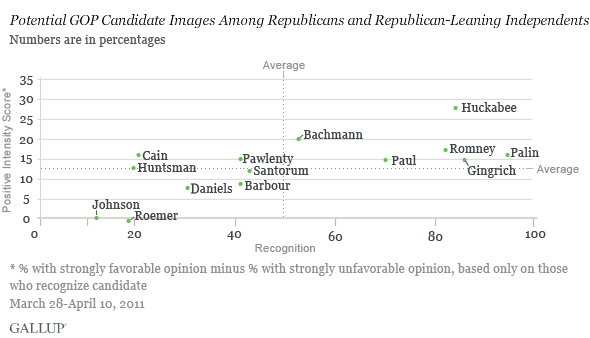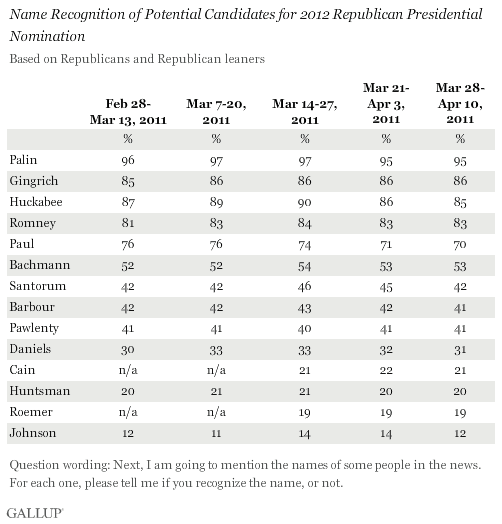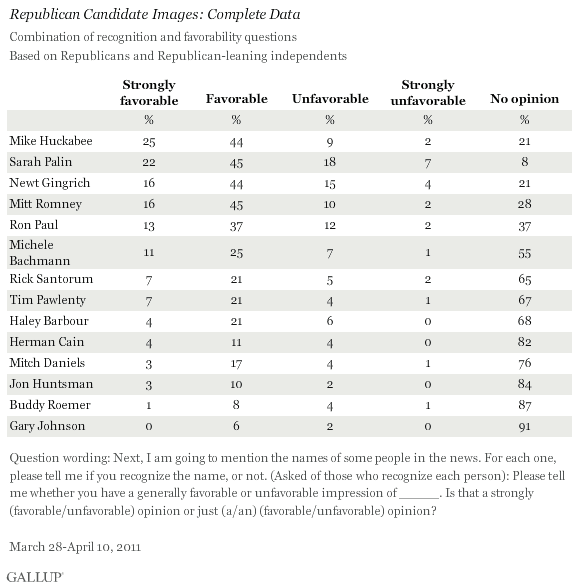PRINCETON, NJ -- Former Massachusetts Gov. Mitt Romney, who Monday announced the formation of a presidential exploratory committee, is among the most recognized Republicans who are thought to be most likely to run for president in 2012. At the same time, his Positive Intensity Score among Republicans nationwide does not stand out.

Romney joins several Republicans who have entered the curious territory of taking tentative steps toward a presidential candidacy, while not making it official. This group includes Newt Gingrich, who announced the creation of a website, "Newt Explore 2012," and Tim Pawlenty, who, like Romney, has set up a presidential exploratory committee.
None of these three semi-candidates are leaders among Republicans in terms of Gallup's Positive Intensity Scores. Former Arkansas Gov. Mike Huckabee continues to register the highest Positive Intensity Score (27) in Gallup interviewing conducted March 28-April 10. Minnesota Congresswoman Michele Bachmann trails Huckabee, at 20. A large group of possible candidates with scores in the 15 to 17 range follow her -- including Romney, Gingrich, and Pawlenty. They are joined in that group by Sarah Palin, Texas Congressman Ron Paul, and Georgia businessman Herman Cain. (Complete data for the March 28-April 10 interviewing period follow on page 2.)

Romney is among the best-known potential Republican candidates, reflecting in large part his history as a 2008 presidential candidate. His recognition score of 83% is similar to that of Gingrich (86%), who became widely known as speaker of the House in the 1990s, and Huckabee (85%), who -- like Romney -- was a candidate in 2008. Only Palin (95%) is better known than these three, reflecting her status as a former vice presidential nominee and current television personality.

Implications
Romney's major challenge as he gears up for his presumed presidential run is to generate enthusiasm among potential GOP voters. Romney is in the enviable position of being widely known among Republicans nationwide, which helps him in traditional trial-heat ballot tests among Republicans. But to date, Republicans who know him are not highly likely to show positive intensity in their views of him.
Romney has so far taken a low-key approach to his candidacy, avoiding the national spotlight and sticking to visits in the crucial early primary states such as New Hampshire, where he filmed his new "exploratory committee" YouTube video. He thus has the possibility to increase the positive intensity with which Republicans view him as he ramps up his campaign efforts in the months ahead. Visitors to Romney's new website see pictures and video of the former governor dressed in shirt sleeves, no doubt in an attempt to soften his stiff "suit and tie" image and increase the connection between him and potential voters.
Meanwhile, Republicans continue to feel most positive about Mike Huckabee, despite the fact that he has no exploratory committee and has avoided any statements suggesting that he is going to run for the presidency.
Survey Methods
Results are based on telephone interviews conducted as part of Gallup Daily tracking March 28-April 10, 2011, with random samples of Republicans and Republican-leaning independents, aged 18 and older, living in all 50 U.S. states and the District of Columbia. Questions asking about the 14 potential candidates measured in this research were rotated among randomly selected samples of Republicans each night; over the 14-day period, each candidate was rated by a minimum of 1,500 Republicans and Republican-leaning independents.
For the overall ratings of each potential candidate among Republicans and Republican-leaning independents, including recognition scores, one can say with 95% confidence that the maximum margin of sampling error is ±3 percentage points. For the Positive Intensity Score for each candidate, the maximum margin of sampling error varies depending on the size of the group recognizing the candidate.
Interviews are conducted with respondents on landline telephones and cellular phones, with interviews conducted in Spanish for respondents who are primarily Spanish-speaking. Each sample includes a minimum quota of 400 cell phone respondents and 600 landline respondents per 1,000 national adults, with additional minimum quotas among landline respondents for gender within region. Landline telephone numbers are chosen at random among listed telephone numbers. Cell phones numbers are selected using random digit dial methods. Landline respondents are chosen at random within each household on the basis of which member had the most recent birthday.
Samples are weighted by gender, age, race, Hispanic ethnicity, education, region, adults in the household, and phone status (cell phone-only/landline only/both, cell phone mostly, and having an unlisted landline number). Demographic weighting targets are based on the March 2010 Current Population Survey figures for the aged 18 and older non-institutionalized population living in U.S. telephone households. All reported margins of sampling error include the computed design effects for weighting and sample design.
In addition to sampling error, question wording and practical difficulties in conducting surveys can introduce error or bias into the findings of public opinion polls.
For more details on Gallup's polling methodology, visit www.gallup.com.

